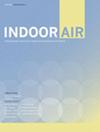不同通风策略对降低教育建筑COVID-19感染风险效果的蒙特卡罗评估
IF 4.3
2区 环境科学与生态学
Q1 CONSTRUCTION & BUILDING TECHNOLOGY
引用次数: 2
摘要
2019冠状病毒病大流行疫情提高了人们对室内环境适当通风的重要性的普遍认识,以降低感染风险。特别要注意的是特定类别的建筑,如学校,由于两个因素:(1)高占用密度和(2)年轻人,有时更容易受到影响的人的存在。尽管对教室通风的警惕性很高,但很难对减轻传染风险的不同策略的有效性进行强有力的分析。事实上,COVID-19大流行仍在持续,多种病毒株的存在、口罩的使用、疫苗接种的进展以及空气净化器和其他卫生设备的安装等诸多因素,使得仅通过分析现有监测数据就难以充分量化房间通风的影响。此外,与通风有关的缓解战略往往是动态的,这增加了评估问题的复杂性。在此框架下,本工作提出了一种新的蒙特卡罗方法,结合建筑性能模拟,在考虑动态边界条件的情况下,评估不同场景下受感染的居住者数量。所描述的方法已应用于意大利博曾-博尔扎诺自由大学的一个案例研究教室,分析了近100种不同的场景,并讨论了传统上采用的不同通风策略的有效性,以确保根据二氧化碳浓度限制适当的室内空气质量。结果强调了结合不同解决方案(例如,混合模式通风和口罩)以限制学生和讲师风险的重要性。本文章由计算机程序翻译,如有差异,请以英文原文为准。
A Monte Carlo Assessment of the Effect of Different Ventilation Strategies to Mitigate the COVID-19 Contagion Risk in Educational Buildings
The COVID-19 pandemic outbreak has increased the general awareness of the importance of proper ventilation in the indoor environment to reduce the contagion risk. In particular, attention has been paid to specific categories of buildings, such as schools, due to two factors: (1) high occupancy density and (2) the presence of young and sometimes more susceptible people. Despite the high level of alertness towards the ventilation of classrooms, robust analyses of the effectiveness of the different strategies to mitigate the contagion risk have been difficult to perform. Indeed, the COVID-19 pandemic is still ongoing, and many factors, such as the presence of multiple viral strains, use of facial masks, progression in vaccination, and installation of air purifiers and other sanitization devices, make it difficult to fully quantify the impact of room ventilation by simply analysing available monitoring data. Moreover, mitigation strategies related to ventilation are often dynamic, increasing the complexity of the problem to assess. In this framework, this work proposes a new Monte Carlo method integrated with building performance simulation to evaluate the number of infected occupants under different scenarios, considering also the dynamic boundary conditions. The described approach has been applied to a case study classroom at the Free University of Bozen-Bolzano, Italy, analysing almost 100 different scenarios and discussing the effectiveness of different ventilation strategies traditionally adopted to ensure suitable IAQ according to CO2 concentration limits. Results highlight the importance of combining different solutions (e.g., mixed-mode ventilation and facial masks) to limit the risk for both students and lecturers.
求助全文
通过发布文献求助,成功后即可免费获取论文全文。
去求助
来源期刊

Indoor air
环境科学-工程:环境
CiteScore
10.80
自引率
10.30%
发文量
175
审稿时长
3 months
期刊介绍:
The quality of the environment within buildings is a topic of major importance for public health.
Indoor Air provides a location for reporting original research results in the broad area defined by the indoor environment of non-industrial buildings. An international journal with multidisciplinary content, Indoor Air publishes papers reflecting the broad categories of interest in this field: health effects; thermal comfort; monitoring and modelling; source characterization; ventilation and other environmental control techniques.
The research results present the basic information to allow designers, building owners, and operators to provide a healthy and comfortable environment for building occupants, as well as giving medical practitioners information on how to deal with illnesses related to the indoor environment.
 求助内容:
求助内容: 应助结果提醒方式:
应助结果提醒方式:


